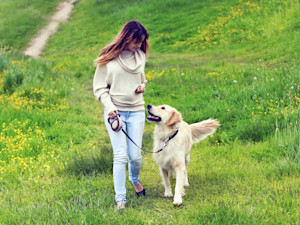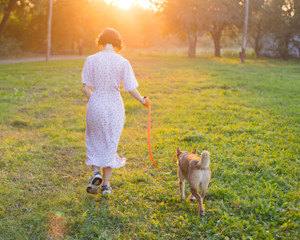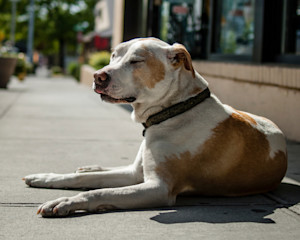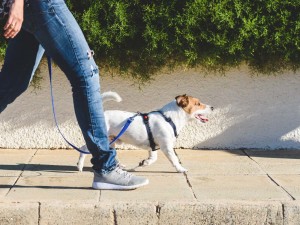Unpopular Opinion: Retractable Dog Leads Are a Bad Invention & These Experts Agree
Not all leads are created equal
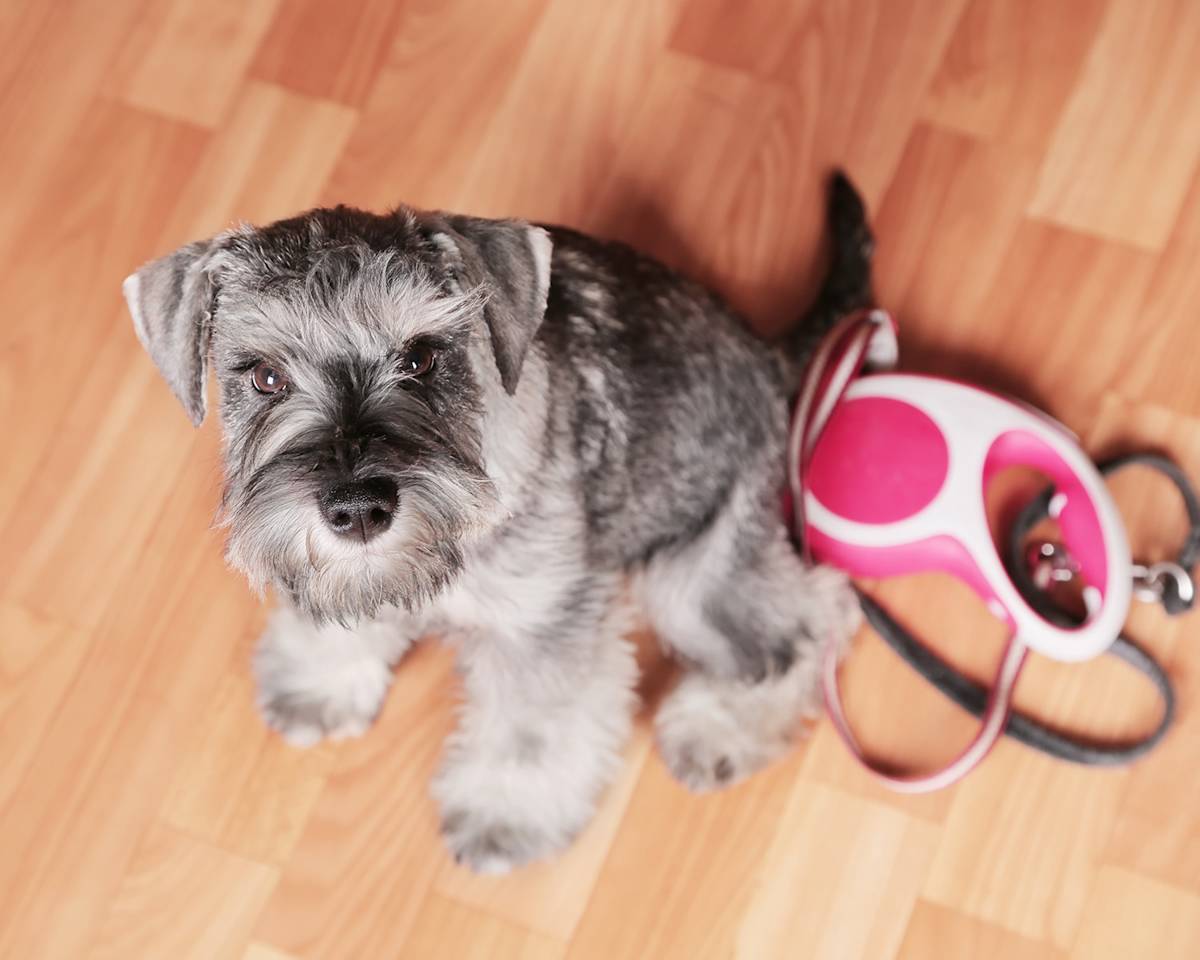
Share Article
Retractable. Extendable. Flexi leads. They go by many names. But no matter what you call them, as a trainer, I think they’re one of the worst things invented for dogs.
Yes, they can be really convenient to give your dog more freedom while ensuring they’re not running off to steal someone’s picnic or harass other dogs. And, as Heather Mortley, a dog trainer and behaviour specialist from Wildshapedopens in new tab, explains, their large handle “can be easier to hold, especially for those with arthritis or other fine mobility-related disabilities.”
But there are some serious downsides to retractable leads – not just for safety but when it comes to actually training your dog as well.
Making training more difficult
Loose lead walking is one of the hardest (and often most boring) things to teach any dog. After all, they weren’t bred to walk in a straight line at the pace of a human.
To make life easier, you want to use equipment that’s going to help you teach them this important life skill, not hinder it. But that’s exactly what retractable leads can do.
“Walking a dog on an extendable lead can make your dog’s pulling worse,” states Heather, who is also registered with the ABTC as an Animal Behaviour Technician (ABT) and Animal Training Instructor (ATI).
“The natural reaction to a dog pulling when on an extendable lead is to let out more of the lead, which can act as a reward, reinforcing the pulling. As there is always tension on the lead, it also means that it is almost impossible to reward your dog for walking on a ‘loose lead’. Having a lead with constant tension and no slack becomes normal for them.”
It’s not just general pulling on the lead you can accidentally reinforce with a retractable lead. It’s any behaviour that involves your dog trying to access something outside, whether that’s chasing birds or squirrels, jumping up at people or lunging at other dogs.
If they’re on a flexi lead and you haven’t locked it, chances are they’re going to achieve their goal and learn exactly what to do the next time.
Safety risks of retractable dog leads
“As a vet and a dog owner, I’m not a fan of retractable leads,” admits Dr Angela Jones, co-founder of Petscribersopens in new tab. “They offer limited control, especially in busy or unpredictable environments.”
And that can spell danger not only for you and your dog but for others in the area. One of the big issues comes from using these leads on pavements. As Dr Jones explains: “They’re very difficult to retract once fully extended, so a dog can easily dart into a road or towards another animal, risking injury.”
Everyone thinks it won’t happen to their dog. But dogs aren’t robots and can behave unpredictably at times (just like we can). “Dogs are natural hunters who will go and chase,” says Jo Sellers, separation anxiety specialist and owner of Pippin Pets Dog Trainingopens in new tab. “Even the most trained dogs have instincts [and] you cannot control cats and wildlife nearby.”
The lead itself can be dangerous, too. If dogs “reach the end of the lead at speed, the sudden jolt could cause neck injuries,” says Dr Jones. “The thin cord also poses a physical hazard. It can tangle, trip or cause painful rope burns to both dogs and people.” That can easily happen if two dogs try to play with each other and get caught up.
And what about if the locking mechanism breaks? A behaviourist colleague told me a tragic story of someone whose extendable lead snapped in a field of sheep, resulting in their dog being shot. Even if you don’t live in the countryside and will never step foot in a sheep field, a similar fate could occur on a busy road.
Jo points out one final danger to be aware of for dogs who may be sensitive to noises. The mechanism and clicking sound “can be scary,” she says. “The handle is clunky and large and can easily get pulled out of the owner’s hand,” spooking some dogs into running off.
Safer alternatives to retractable dog leads
If you want to give your dog some freedom as they can't safely be off-lead, every expert I spoke to recommends using a longline lead instead. Heather recommends a five or ten metre one with a rubberised grip so you can use it rain or shine. If you find them tricky to use, Dr Jones advises wearing gloves and seeking the help of a trainer or behaviourist.
For everyday walks or tighter areas like pavements, a two or three metre lead “is much more practical,” Jo says. “You can loop up the excess in your hand and feed out the line to give the dog more room. With this length, they are not too far away from you so cannot get into trouble.”
Plus, your dog will be able to sniff to their heart’s content – which is a need we should all aim to meet – and you can keep the lead loose which will make lead training so much easier.
There may be a time and place
No one’s saying you can never use a retractable lead ever again. But it’s worth considering when it’s most sensible to use one.
As Róisín Bolger, Vet Lead at pet charity Blue Crossopens in new tab, says: “When used carefully and with the right sort of dog, retractable leads are useful for giving dogs some extra freedom on walks.”
She mentions parks and other open spaces as being good places to use them, adding: “This type of lead should be used with a harness, not a collar, to avoid potential neck injuries.”
Róisín cautions against using them, even in open spaces, with “dogs who are very strong on the lead or dogs who can react quickly if scared or excited”.
It’s also a good idea to use an extendable lead that’s made with a thicker tape lead instead of a thinner cord. This can help reduce injuries if something were to go wrong. And don’t forget to make sure your lead is strong enough for your dog – most manufacturers will state if there’s a weight limit.
So, the next time you go to buy a new piece of equipment for your dog, think carefully about what’s going to make life easier (and safer) for you, your dog and everything around you. It may not be what you think.

Lauren Sharkey
Lauren Sharkey is a journalist-turned-dog behaviourist who runs Winnie’s Worldopens in new tab: a training and behavioural company that aims to give dogs and their pet parents the life they deserve. She shares her life with a Shar Pei named Winston, who is the inspiration for her career change along with being her biggest love (and challenge!).
Related articles
![Dog lying on a brick street with a leash]()
“Why Won’t My Dog Walk Outside?”
Dog behaviourist Karen B London’s top tips to help get your parked pet moving
![dog bouncing on lead in the countryside with girl]()
How to Make On-Lead Dog Walks More Exciting
There are plenty of ways to spice them up
![Woman walking a dog on a lead]()
Why Keeping Your Dog On The Lead Isn’t ‘Bad Pet Parenting’
Keeping your dog on a lead isn’t mean – sometimes, it’s the kindest choice
![Person in dress walking away on a field with a dog]()
Neutrality Walks: The Overhyped Trend Dogs Don’t Need
Your dog’s joy > social media trends
![Dog sunbathing in the sun on pavement]()
When is it Too Hot to Walk Your Dog?
Even if it’s nice for us, it can very easily be too hot for your pup
![Dog walker walking with her pet on leash on the sidewalk]()
10 Tips You’ll Definitely Want to Follow When You Walk Your Dog
From the safest gear to training recommendations



